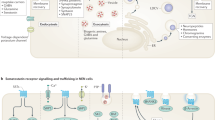Abstract
ERSPAMER1 was the first to assume enterochromaffine cells of the gastrointestinal tract to contain enteramine (5-hydroxytryptamine serotonin). Feyrter2 regarded these cells as a part of the entity he calls the “Helle-Zellen-Systeme” in general, subdividing it into the “Insuläres Gangorgan” of the pancreas, the probable origin of glucagon (Gaede, Ferner and Kastrup3), and the “Gelbe-Zellen” or enterochromaffine cells of the gastrointestinal tract. Carcinoids, which are tumours originating from these cells, have already been examined with regard to pharmacodynamically active substances by Feyrter and Unna4 and by Selberg5. Their results were inconclusive and divergent.
This is a preview of subscription content, access via your institution
Access options
Subscribe to this journal
Receive 51 print issues and online access
$199.00 per year
only $3.90 per issue
Buy this article
- Purchase on Springer Link
- Instant access to full article PDF
Prices may be subject to local taxes which are calculated during checkout
Similar content being viewed by others
References
Erspamer, V., Arch. Exp. Path. Pharmakol., 218, 92 (1953).
Feyrter, F., “Über die peripheren endokrinen Drüsen des Menschen” (Maudrich, Vienna and Düsseldorf, 1953).
Gaede, K., Ferner, H., and Kastrup, H., Klin. Wochenschr., 388 (1951).
Feyrter, F., and Unna, K., Virchow's Arch., 298, 187 (1936).
Selberg, W., Klin. Wochenschr., 1271 (1941).
Author information
Authors and Affiliations
Rights and permissions
About this article
Cite this article
LEMBECK, F. 5-Hydroxytryptamine in a Carcinoid Tumour. Nature 172, 910–911 (1953). https://doi.org/10.1038/172910a0
Issue Date:
DOI: https://doi.org/10.1038/172910a0
This article is cited by
-
Carcinoid Tumors: Past, Present, and Future
Indian Journal of Surgical Oncology (2020)
-
Serotonine anders bekeken
Huisarts en Wetenschap (2006)
-
Résumés des communications du Groupe Européen de Pathologistes spécialisés en ponctions sous échoendoscopie digestive / Abstracts of European Pathology Group communications on EUS-FNA
Acta Endoscopica (2005)
Comments
By submitting a comment you agree to abide by our Terms and Community Guidelines. If you find something abusive or that does not comply with our terms or guidelines please flag it as inappropriate.



